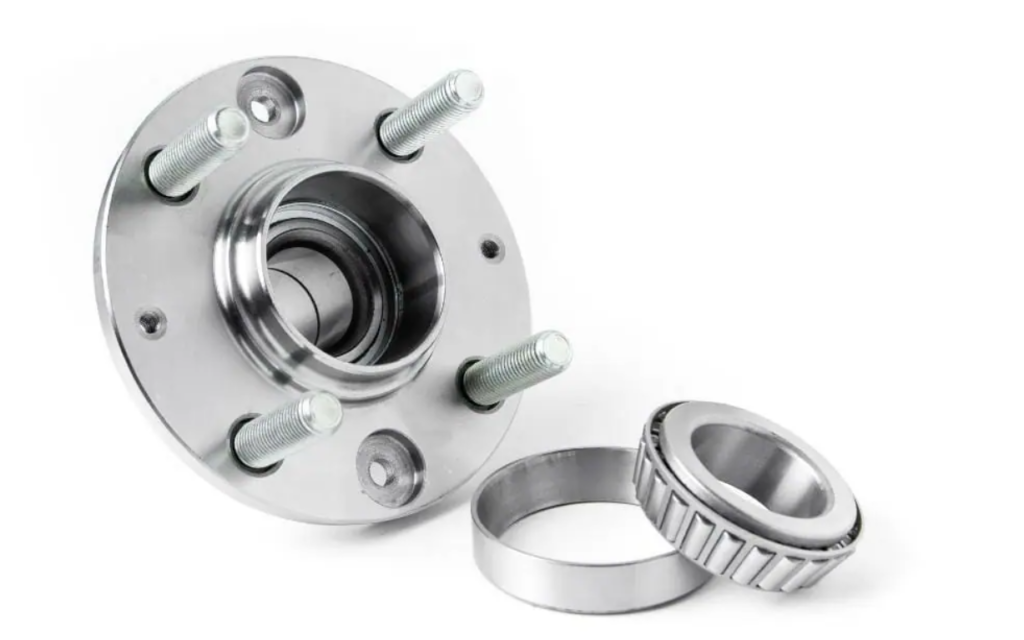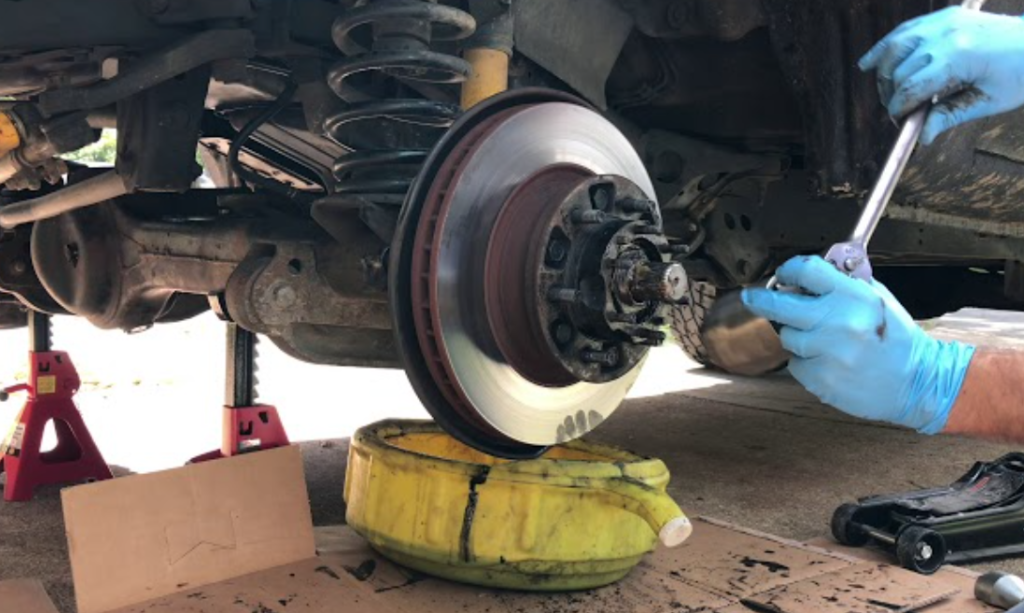Wheel bearings might not be the first thing that comes to mind when we think of vital vehicle components, but their role is pivotal in ensuring a smooth ride. These small yet essential parts are tasked with reducing friction as the wheels spin. Essentially, they act as the bridge between the wheel and axle, allowing for free rotation without causing wear to the wheel hub. This translates to the ease with which your vehicle moves and the overall ride quality. Their seamless operation is imperative; even a slight fault can throw a wrench into your vehicle’s performance. Thus, understanding the average life of wheel bearings, anatomy, and the signs of wear is crucial for every vehicle owner.

Anatomy of Wheel Bearings
At first glance, wheel bearings might seem uniform in design and function. However, delve deeper, and you’ll find a range of types tailored for various vehicles and uses.
- Ball Bearings: As the name suggests, these bearings contain ball-shaped elements sandwiched between inner and outer rings. They are versatile and commonly found in many vehicles due to their ability to handle both radial (vertical) and axial (horizontal) loads simultaneously.
- Roller Bearings: Instead of balls, these bearings employ cylindrical rollers. They’re excellent for managing heavier radial loads but aren’t as adept at handling axial loads. Given their design, they’re often found in larger vehicles like trucks or machinery where weight distribution plays a crucial role.
- Tapered Roller Bearings: These are a variation of roller bearings but with a slight taper in the rollers, allowing them to handle both radial and axial loads efficiently. Their versatility finds them a place in many car wheel hubs.
Beyond just types, wheel bearings don’t function in isolation. They work cohesively with other car components, ensuring that every turn of the wheel is harmonious and friction-free. Their positioning between the brake disc and the drive axle and within the hub means they interact closely with these parts. The brake system, for instance, generates a significant amount of heat. Quality wheel bearings ensure this heat doesn’t impact the tires or the drive mechanism. Moreover, they bear the vehicle’s weight and ensure that despite road irregularities, the drive remains as undisturbed as possible.
In essence, while they might seem small and inconspicuous, wheel bearings have a layered structure and function, making them indispensable to your car’s optimal operation.
Factors Influencing the Average Life of Wheel Bearings
Quality of the Bearing Material
The composition and quality of a wheel bearing can make a marked difference in its lifespan. Premium wheel bearings are crafted from high-grade steel or other durable materials, ensuring they withstand stress, heat, and wear for prolonged periods. These materials are treated to be resistant to corrosion and wear. In contrast, bearings made from inferior materials are more susceptible to early wear, can corrode easily, and may not offer the same performance level. Over time, the initial savings from choosing cheaper bearings can be overshadowed by frequent replacements and potential damage to related components.
Driving Conditions
The terrain you typically traverse has a direct impact on the longevity of your wheel bearings. Frequently driving on rough terrains, bouncing over potholes, or indulging in off-road adventures can exert undue stress on the bearings. Such conditions often lead to external contaminants like dirt or tiny stones getting lodged within the bearing, causing premature wear.
Exposure to Moisture and Dirt
Wheel bearings come with seals to keep out contaminants. However, over time or in particularly harsh environments, these seals can degrade or become compromised. When moisture or dirt infiltrates a bearing, it can erode the material and interfere with its function. Consistent exposure to water, especially saltwater, can expedite corrosion, reducing the average life of wheel bearings and bearing’s efficiency.
Vehicle Weight and Load
Regularly loading your vehicle beyond its recommended weight limit puts additional stress on the wheel bearings. Overburdening a vehicle, whether with passengers or cargo, can lead to the premature wearing out of the bearings, as they work harder to facilitate smooth wheel movement.
Proper Installation
The intricacies of wheel bearings necessitate a precise installation process. Improperly installed bearings might not function optimally from the outset, leading to reduced efficiency and a shorter lifespan. Thus, entrusting installation to a seasoned mechanic is imperative.
Average Life of Wheel Bearings
Typically, wheel bearings should last between 85,000 to 100,000 miles. However, this range can vary based on vehicle type and usage:
- Vehicle Type: For instance, a heavy-duty truck may experience bearing wear sooner than a lightweight sedan due to the stress of carrying heavy loads.
- Drive Type: Front-wheel-drive vehicles might exhibit faster wear in their front bearings due to the combination of steering and propulsion in the same components. Similarly, all-wheel-drive vehicles could have a more even wear pattern, given the distribution of forces.

Signs of Failing Wheel Bearings
Unusual Noises
One of the telltale signs of a failing wheel bearing is the emergence of strange noises like roaring, clicking, or humming from the wheels. These sounds may become more pronounced with increasing speed.
Uneven Tire Wear
Bad bearings can lead to an uneven distribution of weight, causing tires to wear out prematurely or inconsistently.
Wobbly Wheels
If there’s excessive play or vibration in the wheel when you shake it, it’s a strong indicator of a worn-out bearing.
ABS Light Activation
Modern vehicles come with wheel speed sensors that are part of the ABS system. A compromised wheel bearing can affect this system, illuminating the ABS light on your dashboard.
Decreased Handling or Steering Response
As wheel bearings degrade, they can affect the vehicle’s handling. You might notice decreased steering responsiveness or a sense of “drag” while driving.
Importance of Timely Wheel Bearing Replacement
Ignoring the early warning signs of failing wheel bearings is a perilous game. Wheel bearings, although small and often overlooked, play an instrumental role in ensuring your vehicle’s wheels rotate smoothly and steadily. They bear the weight of the vehicle and sustain the forces generated during acceleration, deceleration, and turning.
Risk of Ignoring Bad Bearings
If deteriorating bearings are neglected, they can seize or collapse. This not only affects the smooth operation of the vehicle but, in extreme cases, the wheel can come off entirely, leading to catastrophic accidents. Even if the worst-case scenario doesn’t manifest, worn-out bearings strain other components of the wheel assembly, increasing the wear and tear on those parts.
Potential Cost of Delayed Replacements
While the immediate financial outlay for replacing wheel bearings might seem substantial, delaying the replacement can end up costing more in the long run. As bearings wear out and become ineffective, they can damage other nearby components, leading to a domino effect of failures within the wheel assembly and brake system. What could have been a straightforward bearing replacement could escalate into a much costlier repair involving brake components, axles, or suspension elements.

Wheel Bearing Maintenance Tips
Regular Vehicle Inspections
One of the best ways to ensure the longevity of your wheel bearings is to have regular vehicle inspections. Trained mechanics can identify early signs of wear or damage, potentially saving you from more significant issues down the road.
Proper Tire Inflation and Rotation
Correct tire inflation ensures an even distribution of weight, reducing undue stress on the bearings. Rotating tires as per the vehicle manufacturer’s recommendations also ensures even wear, prolonging the average life of wheel bearings and tires.
Avoiding Driving Through Deep Water or Extremely Dusty Conditions
Water, especially when mixed with contaminants on the road, can infiltrate and damage the bearing seals, leading to premature wear. Similarly, excessively dusty conditions can introduce abrasive particles into the bearing, decreasing its lifespan. Avoiding such conditions when possible, or taking preventive measures afterward, can be beneficial.
Importance of Using Quality Replacement Parts
When the time comes to replace or repair any component of your vehicle, it’s vital to use high-quality parts. Investing in premium wheel bearings ensures you’re getting a product designed for durability and performance. Cheaper, sub-par alternatives might offer short-term savings but can compromise safety and lead to more frequent replacements.
In essence, the longevity and optimal performance of wheel bearings rely not only on their inherent quality but also on the care and attention they receive. Regular maintenance and timely interventions can guarantee a safer, smoother drive.
Conclusion
Wheel bearings may not be the most glamorous components of a vehicle, but their significance cannot be understated. As the silent guardians ensuring smooth wheel rotations, they bear the weight of the vehicle and the many forces it encounters. While they’re built for endurance, their lifespan isn’t infinite. Proactive care, combined with regular maintenance, is the golden ticket to prolonging average life of wheel bearings and ensuring vehicular safety. In the world of automobile components, it’s often the unseen elements like wheel bearings that play pivotal roles. Recognizing their importance and ensuring they are well-maintained guarantees not only their longevity but also a safer and smoother driving experience for all.
FAQs
How much does it typically cost to replace wheel bearings?
The cost of replacing wheel bearings can vary depending on the make and model of the vehicle, the region, and whether you’re replacing one or both. On average, you might expect to pay anywhere from $300 to $700 for parts and labor combined. Always get a quote from a trusted mechanic before proceeding.
Can I replace wheel bearings myself?
Replacing wheel bearings is a complex job that requires specialized tools and expertise. While it’s possible for experienced DIY mechanics with the right tools to replace them, it’s generally recommended to have a professional handle the task to ensure safety and correctness.
Is there a difference between front and rear wheel bearing lifespans?
Yes, there can be differences in lifespan due to the distinct weight distributions and forces acting on front and rear wheels. For instance, front-wheel-drive cars might experience faster wear on the front bearings because they handle both the car’s driving force and steering. However, individual driving conditions and maintenance play a significant role in determining actual lifespans.
How long can I drive on a bad wheel bearing?
It’s risky to drive with a failing wheel bearing. While some might last thousands of miles after showing initial symptoms, others could fail imminently. It’s crucial to address the issue as soon as symptoms arise to prevent potential accidents and further damage to the vehicle.